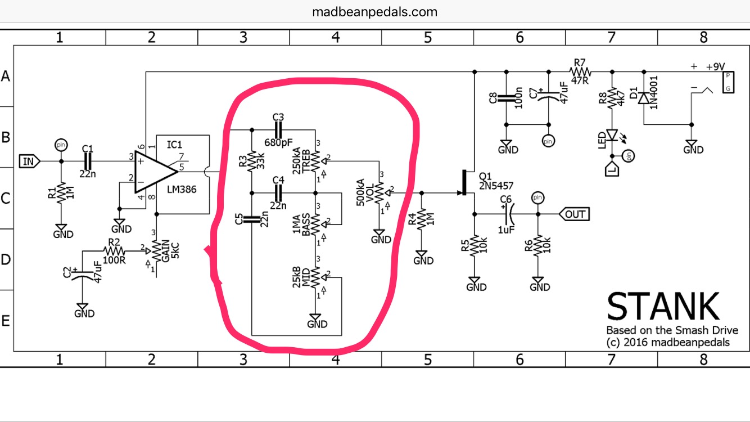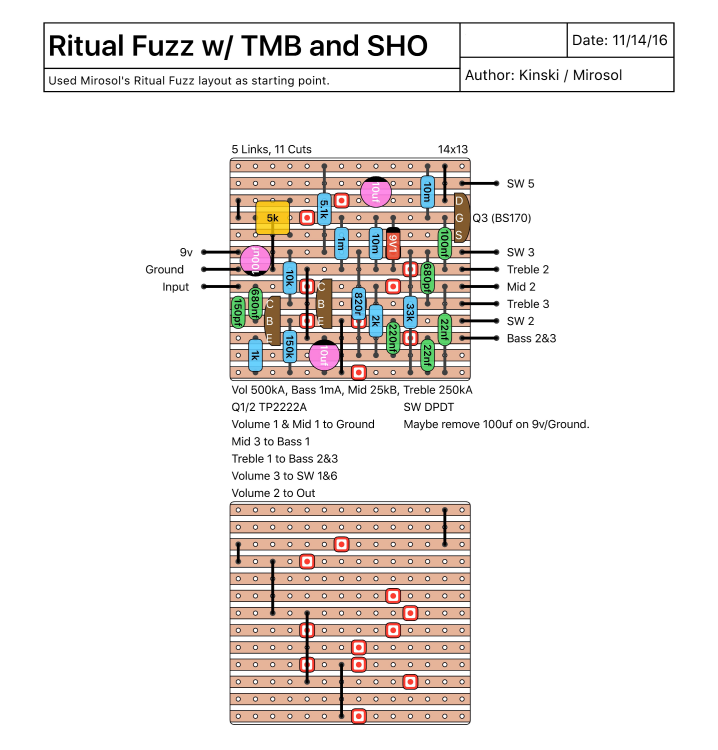Tone Stack Question
|
If I wanted to just take this tone stack to use with a different fuzz circuit, would I just use what I circled in red, or would I need anything else in the schematic? I'm aware I left out the recovery stage. If a recovery was needed I'd just add on an LPB or something similar.
 |
|
Administrator
|
Theoretically you just need what you circled, minus the volume pot. You may need the gain recovery, and doing the LPB or another boost like you said will be a good way to deal with the loss of output.
|
|
Thanks. I was thinking of slapping this at the end of a BA Ritual Fuzz. With a toggle to bypass the tone stack completely.
|
|
Administrator
|
You'll definitely want a booster to recover the lost output. But, it will work, and I like the idea of the tonestack having a bypass switch.
|
|
Will this tone stack really cut that much output that I'd need a recovery when using the ritual fuzz? Seems there is a ton of boost on tap with the Ritual, so that a bit of loss would not matter that much.
|
|
Administrator
|
Believe it or not you'd be surprised how much output you loose. The ritual fuzz, and all one knob fuzzes are basically Si fuzzfaces with fuzz maxed. I built an Si fuzzface with a tone control and the loss of output was astonishing, so I put an LPB boost after it and had to set it on max which gave me a hair over the amount of output I had without the tone pot.
|
|
This post was updated on .
Thanks rocket88.
Here is a layout I made. It's unverified. It's a Ritual Fuzz with a toggle that engages a TMB and LPB-1. Mirosol, I started this layout using your Ritual Fuzz layout. I hope you don't mind. If you do, I will remove the layout immediately. <EDIT: Layout Updated> 
|
The lower leg of your 2k Q2 collector resistor needs to move down one row to connect with the output cap and the 820r power resistor. |
|
In reply to this post by Kinski
Bear in mind that one of the most important factors when it comes to passive tone stack performance is the input impedance of the following stage, which has a major impact on both output volume and frequency response. (The output impedance of the previous stage is also important, but often not quite as critical.) Very often the boost you get from a make-up gain stage has less to do with the actual gain of that stage than with the input impedance of that stage.
As a make-up gain stage, the LPB-1 is a fairly limiting choice, as its input impedance is usually somewhere around 47k. The MXR Micro Amp, or ZVex SHO, on the other hand, have input impedances north of 1M. Neither is an especially difficult circuit, but the SHO is nearly as simple a circuit as the LPB1, and it doesn't add noticeable distortion of its own when you keep the gain set below 75% or so. To see the difference for yourself, open up your Duncan Tonestack Calculator, select the Marshall tonestack, change C1 to 680p and you'll have the tonestack shown above. Now change the load resistor (R5) from 47k to 1M and see the difference in output. Play with the TMB controls and switch R5 back and forth. In addition to the obvious differences in output volume, you should notice a massive difference in frequency response for different loads. One setting where the difference is striking is Treble and Bass at max, Mid at min. A good rule of thumb is this: a high load impedance will give you everything you can get from a low load impedance, plus a lot more, especially when it comes to bass response. In other words, your controls will be much more responsive and wide-ranging with a higher load impedance than with a lower one. This is of course in addition to the increased output. Of course, if you like the LPB-1 as a makeup stage, then by all means use it. With a lossy tonestack, it will almost certainly be better than no makeup stage at all. At minimum, it will prevent your circuit from behaving differently when fed into different amps or other pedals. But if you want more tone options and more output, at least consider a SHO or a Micro Amp (or any other clean boost with a high input Z). In the end, let your ears and your breadboard be your guide. |
|
Administrator
|
Induction to the rescue! I had suspected that impedance would be an issue here, so it's great to hear your input induction.
I also prefer the SHO as a "building block" compared to the LPB. With the LPB the gain of the transistor is fixed at a high level with a "master volume" whereas the SHO has variable gain. The variable gain has better noise performance and less distortion when you don't need the gain at max. That's not even mentioning the input and output impedance. My question to you is this induction; What would be an ideal scenario for the output impedance for the previous stage (directly preceding the tonestack)? A stable low output impedance? Would a buffer in that position help to stabilize the performance of the tonestack? This is something I've wondered about a lot, as I see people having issues with simply hacking a tonestack into an existing circuit Thanks induction |
|
Wow, interesting conversation here. As usual, I'm learning a ton hanging out in this forum.
The layout above has been updated. Thanks nocentelli! I chose the LPB-1, since it seems a common boost to use for recovery around here, but also because the volume can be set all the way off if needed, and its small. The SHO at lowest setting is around unity. Also, the "crackle okay" part is pretty annoying when used on a gig for my use. You know of any other circuits that could be used as recovery that would do what the LPB-1 does, but can be set of OFF? Perhaps an SHO, with the stock pot as a trimpot to set top volume. Then add an external volume pot on the output of the SHO? |
|
In reply to this post by Travis
Hi Travis.
The general rule is that a passive tonestack fed by a stage with a low output impedance will have stronger high frequencies than one fed by a stage with a high output impedance. Whether you need a buffer depends on how much high end you want, and where the tonestack fits into the circuit. If the tonestack comes after an active stage, the difference will be less noticeable than if it comes right after the pickups, which is not to say it won't be noticeable at all. Phil Abbott over at FSB has published an excellent EQ circuit (google 'Phabbtone', there are too many threads to link them all here). Phil argues that contrary to popular belief, passive pickups will provide plenty of juice to feed a lossy, passive tonestack (the Phabbtone is based on the HiWatt tone stack, which is well within the Fender/Marshall family). I wanted to test his claim, so I built the Phabbtone with a switchable input buffer and put it directly after the guitar. I found that without the input buffer, I lost a significant amount of treble and I could not recover it with post-eq. On the other hand, with the input buffer engaged, I actually had too much treble, and had to set the treble control close to zero, otherwise it was overwhelming. The best result required an inline resistor between the buffer and the tonestack, to increase the effective output Z of the buffer. Now I use the Phabbtone (input buffer switched off) as my slave amp tonestack, in a re-amping setup. So the answer to the question boils down to setup and sonic goals. I would not want to use the phabbtone with the input buffer as pre-dirt EQ, because the dirt would get shrill. After dirt, the input buffer is generally not necessary impedance-wise, and again can preserve too much treble, but the result is less piercing and brittle than the pre-dirt scenario. Bottom line, you want the output impedance feeding the tone stack to be in the goldilocks zone for the result you're trying to achieve. If you're going for classic rock guitar tone, your 'just right' will probably different than if you're going for modern metal, etc. Your best EQ for clean tones will probably be different than for pre-dirt EQ, which will also be different than post-dirt EQ, not to mention whether you think of 80's power ballads vs. The Black Keys when you dial in your 'clean' tones. Even the idea of presenting a consistent output Z to the tone stack can be debated, as you may find the EQ change that you get from rolling off your guitar volume knob (and the resulting increase in output Z that feeds the tone stack) to be welcome or unwelcome. I guess you've noticed that I've studiously avoided a direct answer to the question, but I hope I've helped give some guidance as far as how to approach the question for yourself. In the end, design questions are mostly dependent on goals and tastes (as long as nothing blows up or electrocutes someone). 'Good design practice' is far more open to debate in analog guitar equipment than in most other fields of electronics. Edit: That would be my suggestion. |
|
Administrator
|
This post was updated on .
I couldn't ask for a better explanation. I feel like you pretty much covered all bases brilliantly in one post. Thanks for your thoughtful insight induction, I really appreciate it!
Kinski - of course I agree with induction regarding the SHO. Use a 5K trimmer to set the max output and then a 100K pot will work great as a master volume just like the Super Duper for example (just remove the 100K resistor to ground at the output of the standard SHO circuit) |
|
Administrator
|
Tacked a little edit onto my post as I forgot to mention to remove the 100K to ground at the output when you add the master volume :)
|
|
This post was updated on .
Okay, here is the same circuit with an SHO instead of the LPB-1.

|
|
In reply to this post by induction
Shout out to Induction, this was very educational and I appreciate you sharing your experience/knowledge.
|
«
Return to Open Chat
|
1 view|%1 views
| Free forum by Nabble | Edit this page |

